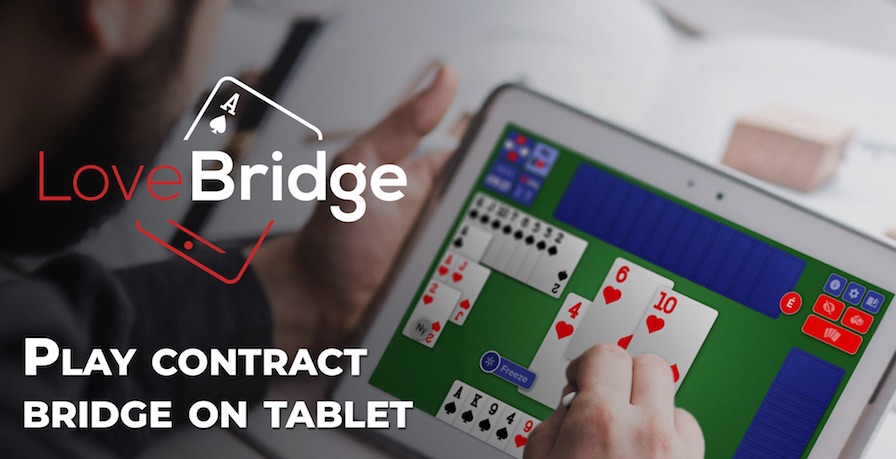September 29, 2018 at the 15th World Bridge Series in Orlando Florida, a collection of some of the top players in the world sat down to test out a new tablet-based method for playing bridge. Alex talks to LoveBridge founder Péter Talyigás about this interesting new way to play bridge.
LoveBridge – Where Cards and Technology Meet

LoveBridge – Where Cards and Technology Meet
by Alex J. Coyne © 2018 Great Bridge Links
September 29, 2018 at the 15th World Bridge Series in Orlando Florida, a collection of some of the top players in the world sat down to test out a new tablet-based method for playing bridge. The players sat North/East at one table and South/West far away.
Update August 26, 2019: LoveBridge was used in the BAM at the World Youth Bridge Championships. Watch an interview with Péter Talyigás on youtube here
With no partner at the table the risk of cheating would certainly be less, and many ethical difficulties can be avoided.” Said Boye Brogeland, who came second in the 10-board match. “Is it worth the prize of removing physical cards and changing the social aspect of the game? I still don’t think so, but wouldn’t be surprised if I changed my mind after getting comfortable playing on LoveBridge.”
LoveBridge is an interesting new way to play bridge: Imagine playing with a tablet device instead of using a deck of cards for your next game? No duplicate boards, no bid boxes, no score sheets!
We tracked down Péter Talyigás from LoveBridge.com for an interview so we could find out more about the real deal behind what LoveBridge does and how it works.
According to Peter, LoveBridge.com first started in August 2017: “The original idea came from our founder Gyula Bódis and one of our colleagues Gábor Macskásy.” Gyulla and another colleague made it to the Pairs Final at the Bridge World Series, and were looking for a way to make technology serve the game better.
When asked about the differences between LoveBridge and your regular bridge game, he says rather cryptically, “There are a lot, and there is none…Let me explain: To play with LoveBridge, you simply play bridge as usual.”
He says the entire system has been designed by a team of experienced bridge players to allow players to focus on their game as much as possible. “Bidding and alerting is adapted to the competition form, whether there’s a screen on the table or not, and it follows the rules as they are today.”
“For example, when there are screens, the bids from the other half of the table arrive simultaneously and the alerts can be seen only by the ‘screen-mates.’”
And, there is no ‘undo’. “We preferred to set the scene where mis-clicks can be avoided or corrected without being visible for the other players.”
One-way transmissions are sent through to the vugraph available on their website. “The vugraph itself is designed so that we as lovers and usual followers of bridge broadcasts put all of our ‘wish-list’ features into it: The desktop viewing screen can be divided into four, so you can follow the game on four tables at the same time.” The same screen also gives you all the important player information, including frequencies and the individual player scores.
This has a lot of obvious benefits, like easier card playing for those with arthritis – and features such as being able to set the size of fonts or cards when you need to. Other adjustments can be made, like the way cards are played either through drag-and-drop or double-clicking. They plan to add another feature that allows the game’s organizer to set a time-delay for the vugraph display.
There are even added safety features added to the system, says Peter. “There are no operator mistakes in the broadcasts, and the bids and plays shown on the vugraph are identical to what’s happening in real-life…This is not online bridge. The server and tablets communicate in a closer network, so all the information remains secured.”
Still, some people have been apprehensive about the new system. “We’ve had approximately 20 test competitions in Budapest,” says Peter. “We had doubts in at least two fields: Table presence and the elderly.”
Table presence was related to the tactical sensation of the cards, and how people read the way their opponents handle the cards. But, “after a while, players became accustomed to the new interface.”
The biggest surprise during the testing phase was the enthusiasm showed by the elderly for the new technology. “They were extremely enthusiastic.” says Peter. “When we finished testing in one of the clubs after eight weeks, they expressed how disappointed they were when they couldn’t play bridge with their tablets anymore!”
More About LoveBridge
“Three competitions will be held with LoveBridge in the near future.” says Peter.
These are:
IMPs Pairs Championship (Hungary) on the 17thand 18th of November 2018;
the first division of the IMP pairs (4thof December and on 8 consecutive Tuesdays)
and the 42nd International Budapest Bridge Festival on the 13thand 17thof February 2019.
All of these events will be broadcast through their website’s vugraph – so stay tuned!








